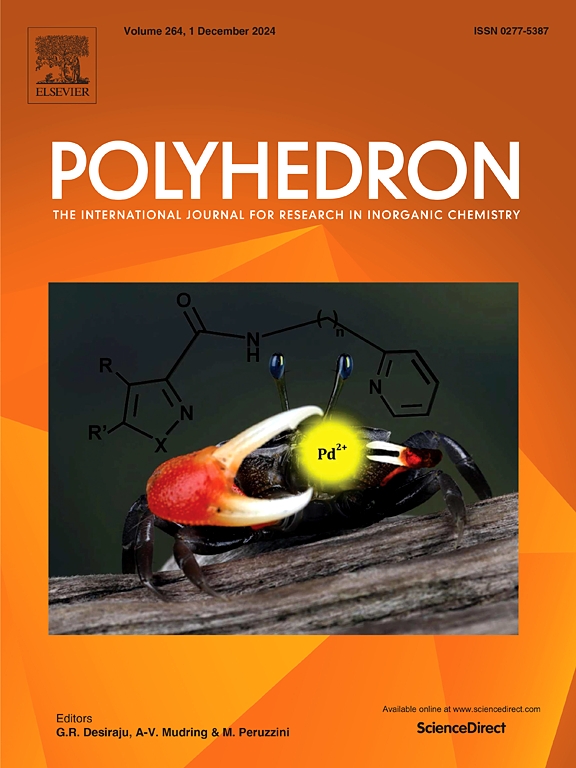Influence of copper valence states on antiferromagnetic Behavior: A Comparative study of three Copper-based polyoxomolybdate hybrid compounds
IF 2.4
3区 化学
Q2 CHEMISTRY, INORGANIC & NUCLEAR
引用次数: 0
Abstract
Three Cu-based polyoxomolybdate coordination polymers, [CuIxCuII1-x(mbpy)(H2O)][CuII(mbpy)(H2O)2][Na(HPO4)(HxPO4)-Mo5O15]·5·.5H2O (1), Cu(mbpy)Mo2O7 (2) and [(CuII(mbpy))(CuIyCuII1-y(mbpy))(H2O)(HyPO4)]2[H3PMoVI10MoV2O40]·H2O (3) (mbpy = 4,4′-dimethyl-2,2′-dipyridyl, 0 < x < 1, 0 < y < 1), have been hydrothermally synthesized. Single crystal X-ray diffraction analysis of compounds 1–3 indicates that three different types of polyoxomolybdate unit, namely Strandberg-type {P2Mo5}, dimeric {Mo2} and Keggin-type {PMo12}, are included, respectively. Compound 1 is constructed by Strandberg-type {P2Mo5} and Cu(mbpy) to form a dimeric unit. Compound 2 has a 1D nanorod-like structure connected by the simplest {Mo2} unit. Compound 3 is an isolated structure consisting of a Keggin-type {PMo12} and a {Cu4} unit. BVS and XPS studies demonstrate that both Cu+ and Cu2+ coexist in compounds 1 and 3, and magnetic measurement indicates the existence of anti-ferromagnetic interactions in compounds 1–3. We proposed three possible magnetic modes, namely {Cu4}, linear {Cu2} and {Cu4-Mo2}, to explain the complex magnetic behavior and try to use both magnetic study and the structure analysis to probe the Cu(I) centers in the compounds.

铜价态对反铁磁行为的影响:三种铜基多氧钼酸盐杂化化合物的比较研究
三种铜基多氧钼酸盐配位聚合物[cuixcui1 -x(mbpy)(H2O)][CuII(mbpy)(H2O)2][Na(HPO4)(HxPO4)-Mo5O15]·5·。5H2O (1), Cu(mbpy)Mo2O7(2)和[(CuII(mbpy))(cuiycui1 -y(mbpy))(H2O)(HyPO4)]2[H3PMoVI10MoV2O40]·H2O (3) (mbpy = 4,4 ' -二甲基-2,2 ' -二吡啶基,0 <;x & lt;1,0 <;y & lt;1),已被水热合成。化合物1-3的单晶x射线衍射分析表明,化合物中含有strandberg型{P2Mo5}、二聚体{Mo2}和keggin型{PMo12}三种不同类型的多氧钼酸盐单元。化合物1由strandberg型{P2Mo5}和Cu(mbpy)构成二聚体单元。化合物2具有由最简单的{Mo2}单元连接的一维纳米棒结构。化合物3是由keggin型{PMo12}和{Cu4}单元组成的孤立结构。BVS和XPS研究表明化合物1和3中Cu+和Cu2+共存,磁性测量表明化合物1 - 3中存在反铁磁相互作用。我们提出了三种可能的磁性模式,即{Cu4}、线性{Cu2}和{Cu4- mo2}来解释复杂的磁性行为,并尝试使用磁性研究和结构分析来探测化合物中的Cu(I)中心。
本文章由计算机程序翻译,如有差异,请以英文原文为准。
求助全文
约1分钟内获得全文
求助全文
来源期刊

Polyhedron
化学-晶体学
CiteScore
4.90
自引率
7.70%
发文量
515
审稿时长
2 months
期刊介绍:
Polyhedron publishes original, fundamental, experimental and theoretical work of the highest quality in all the major areas of inorganic chemistry. This includes synthetic chemistry, coordination chemistry, organometallic chemistry, bioinorganic chemistry, and solid-state and materials chemistry.
Papers should be significant pieces of work, and all new compounds must be appropriately characterized. The inclusion of single-crystal X-ray structural data is strongly encouraged, but papers reporting only the X-ray structure determination of a single compound will usually not be considered. Papers on solid-state or materials chemistry will be expected to have a significant molecular chemistry component (such as the synthesis and characterization of the molecular precursors and/or a systematic study of the use of different precursors or reaction conditions) or demonstrate a cutting-edge application (for example inorganic materials for energy applications). Papers dealing only with stability constants are not considered.
 求助内容:
求助内容: 应助结果提醒方式:
应助结果提醒方式:


